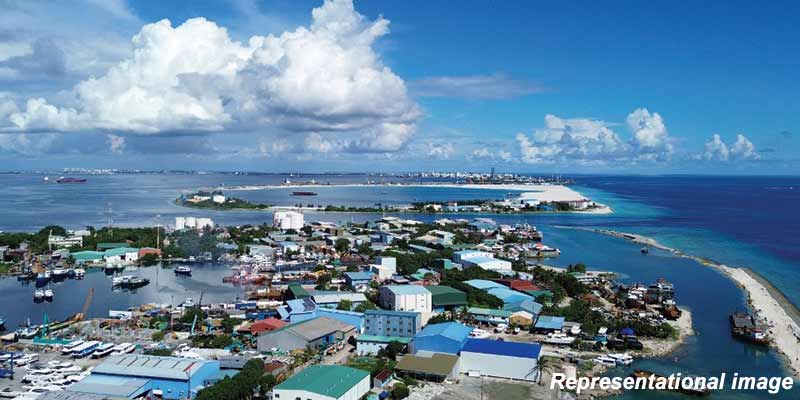- India
- May 11
India withdraws all military personnel from Maldives
• The last batch of Indian military personnel stationed in the Maldives have been repatriated, the government of President Mohamed Muizzu has said, a day ahead of the May 10 deadline set by him for their complete withdrawal from the archipelagic country.
• The relations between India and the Maldives came under severe strain after Muizzu insisted on the withdrawal of Indian military personnel operating three military platforms in the country by May 10.
• Repatriation of some 90 Indian military personnel stationed in the Maldives was a key pledge of Muizzu during his presidential campaign last year.
• The first batch of Indian military personnel was withdrawn from Maldives in early March, followed by the departure of the second batch in April, totalling 51 soldiers.
• The Indian military personnel were stationed in the Maldives to operate and maintain two helicopters and Dornier aircraft India gifted earlier.
• During their tenure there, they contributed to infrastructure maintenance, leveraging helicopters and other resources generously provided by the Indian administration to the Maldives.
• India and the Maldives had agreed to withdraw the remaining Indian troops before May 10 following four rounds of meetings of the India-Maldives High Level Core Group.
India-Maldives relations
• Maldives’ proximity to the west coast of India (it is barely 70 nautical miles away from Minicoy and 300 nautical miles away from India’s West coast), and its situation at the hub of commercial sea‐lanes running through Indian Ocean imbues it with significant strategic importance to India.
• India and Maldives share ethnic, linguistic, cultural, religious and commercial links. Both the nations enjoy close, cordial and multidimensional relations based on shared values of democratic virtues, peaceful coexistence and rule of law.
• India was among the first to recognise Maldives after its independence in 1965 and to establish diplomatic relations with the country.
• India’s prompt assistance during the 1988 coup attempt, led to development of trust and long-term and friendly bilateral relations with the Maldives.
• Both the countries are key players in maintaining safety and security of the Indian Ocean Region (IOR).
• Maldives occupies a very special place in the ‘Neighborhood First Policy’ and the SAGAR (Security and Growth for All in the Region) vision of the government of India.
• ‘India First’ has been a stated policy of the government of Maldives and President Solih, ever since he assumed office in November 2018.
• Bilateral cooperation with Maldives includes the creation of people-friendly infrastructure – housing, water and sanitation, health and education, ports, roads and stadiums. It also includes maritime security, connectivity and people to people exchanges.
Defence: Since 1988, defence and security has been a major area of cooperation between India and Maldives. India has been assisting Maldives in capacity building by meeting its requirements of defence training and equipment. India provides the largest number of training opportunities for Maldivian National Defence Force (MNDF), meeting around 70 per cent of their defence training requirements. A comprehensive Action Plan for Defence was also signed in April 2016 to consolidate defence partnership.
Trade: India and Maldives signed a trade agreement in 1981, which provides for export of essential commodities. India emerged as Maldives’ third largest trade partner in 2021. India‐Maldives bilateral trade crossed the $300-million mark for the first time in 2021, which further crossed $500 million mark in 2022. India emerged as Maldives’ second largest trade partner in 2022. Indian imports from the Maldives primarily comprise scrap metals while Indian exports to the Maldives include a variety of engineering and industrial products like drugs and pharmaceuticals, radar apparatus, rock boulders, aggregates, cement and agriculture produce like rice, spices, fruits, vegetables and poultry produce, etc.
To further ease export and import, in July 2021, India’s Central Board of Indirect Taxes and Customs (CBIC) and Maldives Customs Service (MCS) signed a MoU on Pre-arrival exchange of cargo data. The direct cargo vessel service between India and Maldives started in September 2020 continued its voyages and assisted in keeping the prices low for Maldivian consumers at a time of disruption in supply lines.
Tourism: The Maldivian economy is heavily dependent on its tourism sector, which is the major source of foreign exchange earnings and government revenue. Tourism directly accounts for about a quarter of the Gross Domestic Product (GDP) of Maldives and indirectly for a much larger proportion of GDP. In terms of direct employment, tourism accounts for more than a third of job opportunities for Maldivians and if the allied sectors are included, the contribution of tourism sector in total employment (direct and indirect) would rise up to nearly 70 per cent. Implementation of visa-free entry in February 2022 for Indians arriving in the Maldives for business purposes is a further recognition of the growing commercial partnership. In 2022, India with 2.41 lakh tourists arrivals continues to be the leading source market for Maldives with a 14.4 per cent market share. In March 2022, India and Maldives agreed for an open skies arrangement which will further improve connectivity between two countries.
Manorama Yearbook app is now available on Google Play Store and iOS App Store

